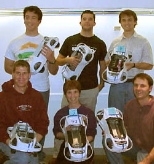A campus car race on Dec. 12 came down to a photo finish--but the two winning teams were happy to share first prize.
The annual race involved model cars built by students in Professor of Mechanical Engineering Timothy Gutowski's graduate-level subject 2.810 (Manufacturing Processes and Systems). Students from several disciplines participated, but the eventual winners were both part of the Engineering Systems Division: they represented the Leaders for Manufacturing and the System Design and Management programs.
The Leaders for Manufacturing (LFM) team included graduate students Brian Bowers, Louis Rassey and David Gerez of management, and Thomas Evans and Jonathan Rheaume of mechanical engineering. The second group included System Design and Management (SDM) graduate students Carol Ann McDevitt and Scott Ahlman, along with graduate students Aubrey Williams, Kelly Harper and Gordon Anderson of mechanical engineering, and Abel Hastings of materials science and engineering.
"We're extremely pleased that two teams from the LFM-SDM enterprise did so well," said Don Rosenfield, director of the LFM Fellows Program. "Not only was this a great educational experience, but the final race was also an exciting sporting event. It's better than season tickets for the Red Sox!"
A team had to lose two races before being eliminated. The fifth and final race determined the winner--or at least, it was supposed to. "It turned out to be LFM and SDM neck and neck, and they came across at the same time," said Gutowski. Although he initially planned a race-off between the two, he decided that both cars had won.
"My job is more to encourage students rather than to pick a winner," he said. "The best thing for the students was for me to acknowledge the two teams that did a really good job."
Each of the seven teams had to design and build various elements of their car. However, they weren't working on just one vehicle; the number of people on the team determined how many car bodies they had to manufacture. The radio control (essentially, the engine) was the only constant. After each round, the car made a pit stop at which the radio control was released from the car's shell and attached to another. This procedure was repeated until eight laps were completed.
The two winners took very different approaches; LFM emphasized simplicity, while SDM concentrated on the robustness of their design. The LFM team devoted an average of about 60 hours per person to the project, while the SDM six-member team put in 190-300 hours each.
"Simple doesn't necessarily mean easy," said Gerez. "Any complexity that doesn't add value is just unnecessary. It should be simple but well thought out. You have to strike a balance."
"My greatest lesson was to always maintain and understand the holistic view of the entire system," said Ahlman, who aside from being an SDM student is also the vehicle dynamics design engineer in the racing department at Ford Motor Co.
The race allowed the students not only to apply what they'd learned about manufacturing and design, but also learn how to function effectively as a group.
"The teamwork aspect was very valuable," said Rheaume. "I learned that sometimes it's difficult to get everyone on board for the same design, coordinate schedules, etc. But even when there are different working styles within the group, that doesn't necessarily mean that the end product won't be something fantastic."
Though locked in competition, the two winning teams respected each other. "Their car was fantastic," said Rassey. "And the attitudes on the track were friendly and everyone was in good spirits."
"I was really amazed to see the complexity in the LFM car because they have much heavier course load than we do," said SDM student McDevitt. "The shop is only open from 8 a.m. to 4:30 p.m., [so] there's very little time they have there. The fact that they were able to manufacture something as good as they did in the time they had available was pretty amazing to me."
"I just think it's neat to have two Engineering Systems Division teams tie for first place, and that each team took a different approach to win the race," said Bowers.
A version of this article appeared in MIT Tech Talk on December 19, 2001.






